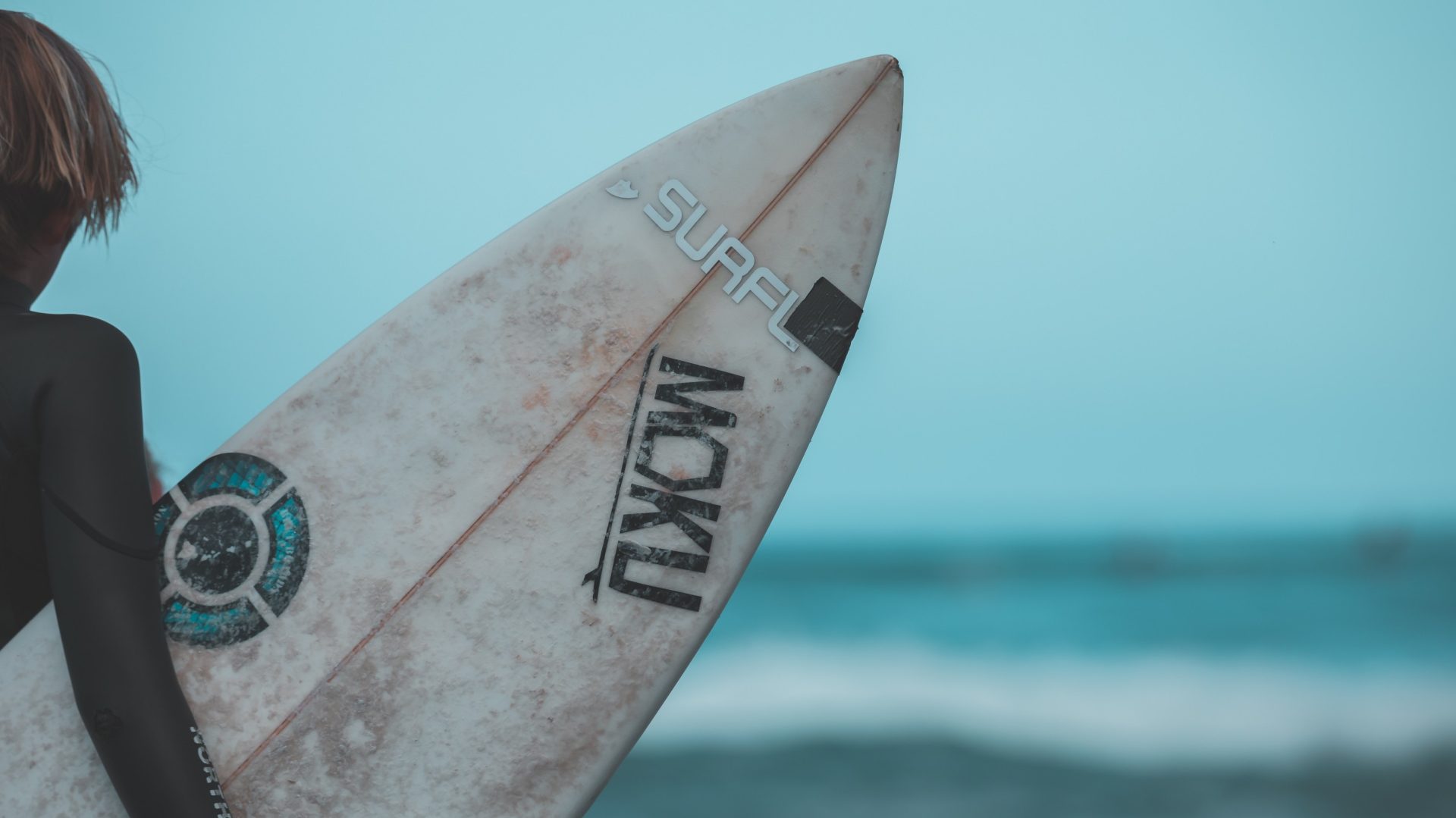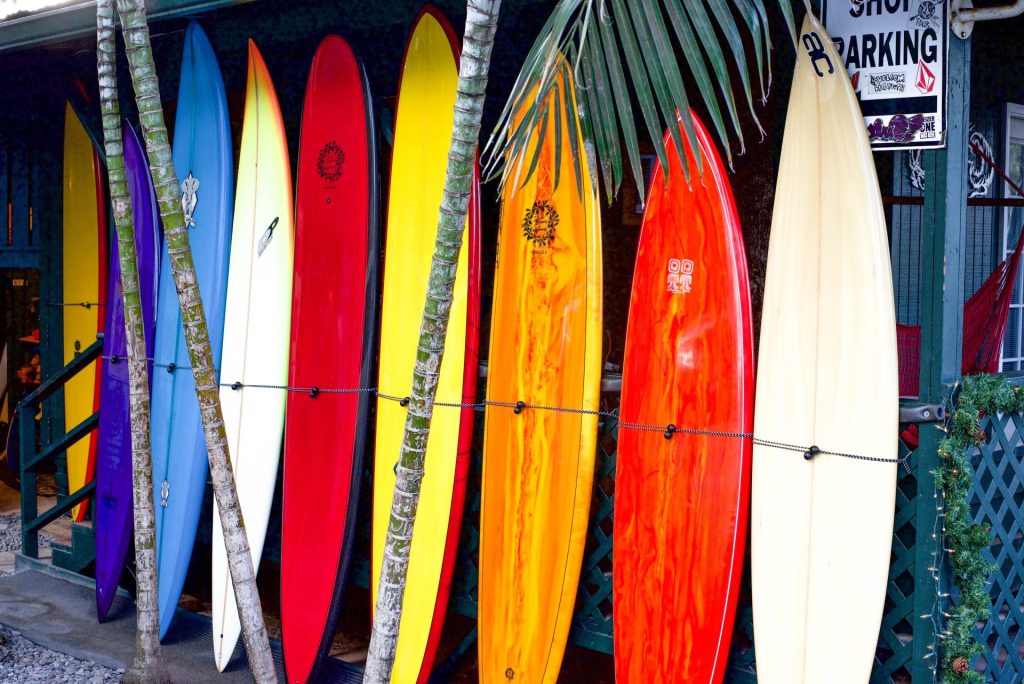The 7 Key Parts of a Surfboard

As surfers we know our surfboard types well, but do we know the different parts of a surfboard?
Each part of a surfboard is very important and will determine what sort of ride it will give you.
Some parts of a surfboard are more influential than others, let's get into it!
What Are The Parts of a Surfboard?
A surfboard has several key parts, including the nose, tail, deck, rails, bottom, leash plug, and fins.
These parts of a surfboard come together to create an amazing tool we use to surf the ocean! So what does each part do?
Parts of a Surfboard Diagram Labelled
This surfboard diagram visually represents of all the parts of a surfboard mentioned above. It helps you understand the placement and relationship of these components on the board:

The Key Parts of a Surfboard
- Nose
- Rails
- Stringer
- Deck
- Bottom
- Leash Plug
- Fins and Fin Plugs
- Outline
- Rocker
- Tail
Surfboard Anatomy
Nose
The nose is the front part of the surfboard. Its shape greatly affects how the board performs in the water. Pointed noses are well-suited for larger waves, allowing for easier paddling and control. Rounded noses work best on smaller waves, making the board more forgiving and agile.
Rails
The rails are the sides of the board, running from the nose to the tail and are actually one of the most important parts of a surfboard. Their shape and thickness play a crucial role in the board's stability and manoeuvrability. Boxy, thicker rails offer stability and are ideal for beginners. In contrast, thin and sharp rails enhance responsiveness, making the board more agile.
Stringer
Think of the stringer as the surfboard's backbone. It's a central support running through the core of the board, providing structural integrity and stability. The stringer also influences the flex pattern and overall strength of the board.
Deck
The deck is the top surface of the surfboard, where you stand while riding. It's often coated with a traction pad to provide grip, ensuring you don't slip while catching waves or performing manoeuvres.
Bottom
The bottom of the surfboard is the part that makes contact with the water. Its shape and contours significantly impact how the board behaves on the wave, affecting speed and manoeuvrability.
Leash Plug
Located at the tail of the surfboard, the leash plug is where you attach your surfboard leash. This ensures that your board stays nearby, even if you wipe out or fall. It's often the most forgotten about parts of a surfboard.
Fins and Fin Plugs
Fins are essential for stability and control. Depending on your surfing style and wave conditions, you can adjust the number and placement of fins. Fin plugs are where fins are inserted, allowing for customisation and easy removal.
Outline
The outline is the shape of the surfboard when viewed from above. It dictates how the board moves through the water, impacting turning ability and overall performance.
Rocker
The rocker is the curve from the nose to the tail is a part of the surfboard not many are familiar with. A mellow rocker suits smaller waves, making it easier to catch and ride them. In contrast, a more pronounced rocker is well-suited for larger, steeper waves, allowing for better manoeuvrability.
Tail
The tail is the back end of the surfboard. Its shape influences the board's pivot and release. Different tail shapes are designed for various types of waves and surfing styles.
Foil
Foil refers to the board's thickness from the nose to the tail. A thin foil enhances manoeuvrability, making the board more responsive to your movements. In contrast, a thicker foil provides stability, which can be ideal for larger waves or less experienced surfers.
Concaves
Concaves are recessed areas on the bottom of the board. They play a significant role in controlling water flow and lift, which directly affects the board's speed and control on the wave.
Traction Pad
Often located at the rear of the deck, the traction pad is a textured area that provides grip. It helps you maintain your footing on the board, especially when making sharp turns or performing tricks.
Still unsure? For those visual learners (like us!) here is video that goes into detail explaining what the parts of a surfboard are called.
Surfboard Types
There are various types of surfboards designed for different wave conditions and skill levels including the fish surfboard. Some of the common surfboard types include:
- Shortboards
- Longboards
- Fish Boards
- Funboards
- Mini Malibu
- Gun Surfboards
- Hybrid Boards
Each type is uniquely suited for specific surfing styles and conditions. Choosing the right surfboard type is essential for maximising your surfing experience.

Summing It Up: What To Do Now
Now you know all the parts of a surfboard and the purpose it serves to you! Cool right!
Has a part of your surfboard been damaged? Ensure you know the different types of dings, so you can quickly work out the best fix for your board.
If your interested in learning more about surfing discover our many guides that will inform you on your surfing journey. Don't forget to follow us on Facebook & Instagram to stay informed on our amazing surf shots and stories shared from surf creators around the world!
Frequently Asked Questions
What is the tip of a surfboard called?
The tip of a surfboard is called the "nose."
What are the layers of a surfboard?
Surfboards typically consist of layers that include foam, fibreglass, and resin.
What is the bottom of a surfboard called?
The bottom of a surfboard is called the "belly" or "underside."
What is the top and bottom of a surfboard called?
The top surface of a surfboard is called the "deck", while the bottom surface is referred to as the "bottom".
Are surfboards called sticks?
Yes, surfboards are sometimes informally called "sticks."
What is the curve of a surfboard called?
The curve of a surfboard from the nose to the tail is called the "rocker."


